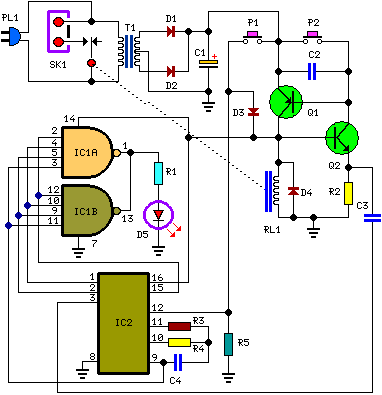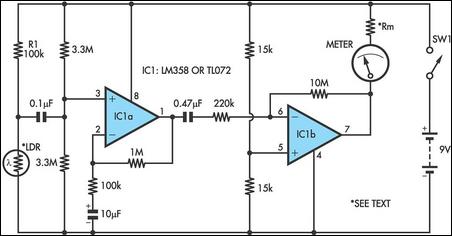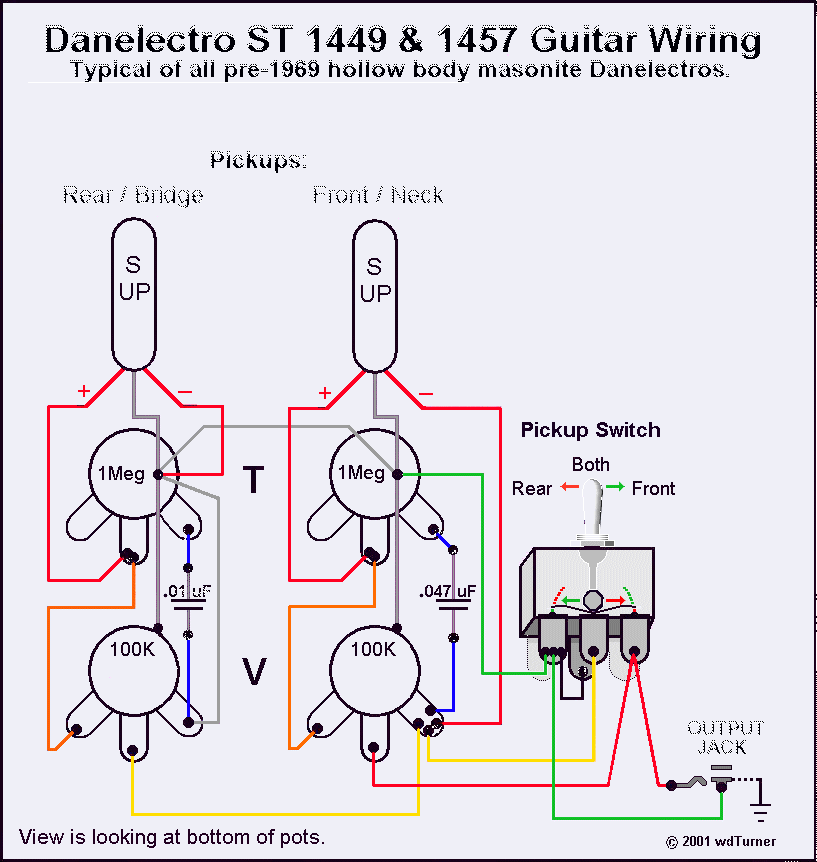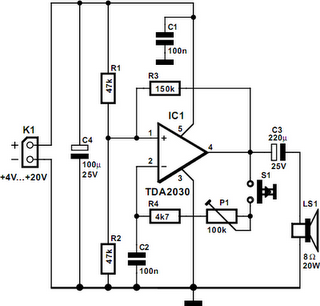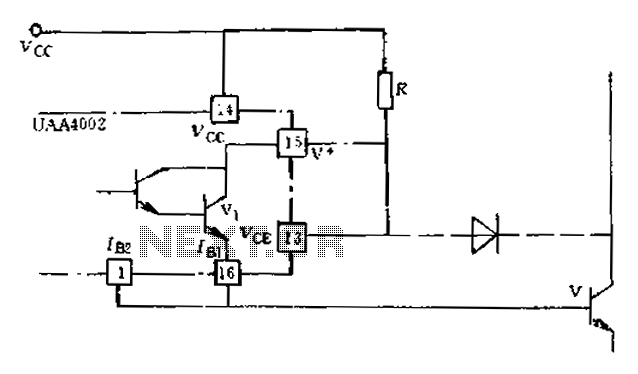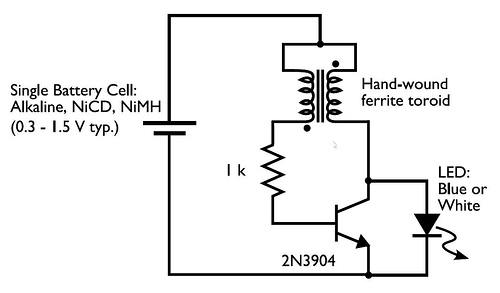
Beeper & Buzzer Schematics
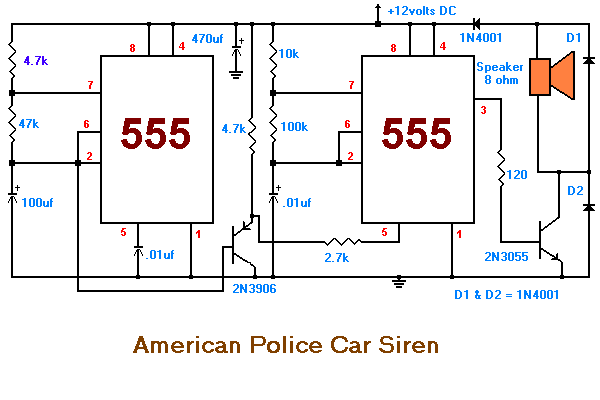
24V DC is a widely used voltage in industrial environments. The circuit illustrated below is designed to accept four different 24V DC alarm input signals, which are utilized to activate a single low-power beeper. The beeper is a magnetic type equipped with its own oscillator/driver. The four diodes create an OR gate, allowing any one of the four inputs to trigger the beeper. A CMOS variant of the popular 555 timer is employed to pulse the beeper on and off at approximately 1Hz. The circuit features a 3V sweeping siren alarm utilizing an LTC1799 precision frequency generator from Linear Technology. Additionally, a 74HC14 hex Schmitt trigger from Texas Instruments is incorporated to perform several functions, including a simple 7Hz square wave oscillator. The 555 timer is utilized as a basic square wave oscillator to generate a 1 kHz tone through an 8-ohm speaker. In this configuration, the speaker is isolated from the oscillator by an NPN medium power transistor, which provides more current than the 555 timer can supply directly (limited to 200 mA). A small capacitor is connected to the transistor. The circuit also includes an American police car siren configuration, where one 555 timer acts as an alarm tone generator while another functions as a low-frequency astable timer, generating a ramp waveform of approximately 6 seconds, buffered by a transistor to modulate the tone generator. Another circuit features a very loud piezo alarm beeper that varies the drive frequency to create an irritating sound, utilizing a transformer to increase the voltage across the piezoelectric device to over 200 volts peak-to-peak, producing a sound level of 120 dB at 12 inches. Automotive and household siren driver circuits, such as the ZSD100 and discrete H-bridge solutions, minimize component counts by employing an application-specific signal generation IC and high-efficiency H-bridge using 3A DC rated Super-TO92 style switching transistors. A basement doorbell beeper circuit is designed to activate a beeper whenever the main door chime is triggered, utilizing a 24VAC power source near the furnace via a current transformer technique. A battery low voltage beeper circuit provides both audible and visual warnings for 12V battery-powered devices, with an idle current of 6mA and a low voltage warning current of 15mA. The beeper bug is a mini tracking device that can be attached to various objects, allowing for tracking via radio. The British police car siren circuit simulates the sound of a police siren using two 555 timers, one as an alarm tone generator and the other as a 1 Hz astable multivibrator. A click sound generator circuit is included to provide audible feedback when a button is pressed in computer-controlled systems, producing a click sound each time the logic input transitions from low to high. A continuity buzzer circuit is designed to detect short circuits while being power-efficient.
The circuit design encompasses multiple functionalities that can be adapted for various applications, including alarm systems, sirens, and notification devices. The use of the 555 timer is prevalent due to its versatility in generating precise timing pulses and oscillations. The incorporation of diodes to create an OR gate facilitates the combination of multiple input signals, allowing for a robust alarm system that responds to any triggered input.
The LTC1799 frequency generator is noteworthy for its precision in generating stable frequencies, which is essential for applications requiring accurate timing such as sirens and alarms. The 74HC14 Schmitt trigger enhances signal integrity, ensuring that the output is clean and free from noise, which is particularly important in digital circuits and when interfacing with analog components.
The design also emphasizes power efficiency, particularly in battery-operated devices, where the low idle current and visual indicators for low voltage conditions are critical for maintaining functionality without frequent battery replacements. The piezo alarm circuit demonstrates the potential for high sound output while maintaining compactness, making it suitable for applications where space is a constraint but loud alerts are necessary.
Overall, this comprehensive circuit description illustrates the versatility and adaptability of electronic components in creating efficient alarm and notification systems, catering to both industrial and consumer applications.24v DC is a very popular voltage used in industrial settings. The circuit below was designed to accept four different 24v DC alarm input signals, which are then used to drive a single low power beeper. The beeper is a magnetic type with its own oscillator/driver. The four diodes form an OR gate so any one of the four inputs will cause the beeper to make noise. A CMOS version of the popular 555 timer is used to strobe the beeper on and off at about 1Hz. 3V Sweeping Siren Alarm - The circuit uses a LTC1799 precision frequency generator from Linear Technology. A 74HC14 hex Schmitt trigger from Texas Instruments is also used to perform several other functions. One section is wired as a simple 7Hz square wave oscillator. 555 Tone Generator 8 Ohm Speaker - This is a basic 555 square wave oscillator used to produce a 1 Khz tone from an 8 ohm speaker.
In the circuit on the left, the speaker is isolated from the oscillator by the NPN medium power transistor which also provides more current than can be obtained directly from the 555 (limit = 200 mA). A small capacitor is used at the transistor. American Police Car Siren (linscott) - Scroll down to locate this circuit. The 555 on the right is wired as an alarm tone generator and the second 555 timer on the left is wired as a low frequency astable timer which generates a ramp waveform of about 6 seconds that is buffered by the transistor and again used to frequency modulate the tone generator.
The transistor is used to help strengthen the signal to the speaker. Another Very Loud Piezo Alarm Beeper - This is yet another beeper circuit that really draws attention. It sweeps the drive frequency slightly to produce a very annoying sound. It uses a transformer to increase the drive voltage across the piezoelectric device to more than 200 volts peak to peak.
It cranks out an ear splitting 120db when measured at 12 inches. Automotive & Household Siren Driver Circuits: Zsd100 & Discrete `H`-Bridge Minimum Parts Count Solution - Zetec Semiconductors Applications Notes A solution is provided that uses a minimum number of components by utilizing an application specific signal generation IC, and a high efficiency `H`-bridge effected with 3A DC rated Super- TO92 style switching transistors. Basement Doorbell Beeper - If you can`t hear your doorbell when you are in your basement try this circuit.
This circuit takes advantage of the 24vac power source located near the furnace. Using a simple current transformer technique, the circuit sounds a beeper whenever the main door chime is activated. Battery Low Voltage Beeper - This circuit provides an audible and visual low voltage warning for 12V battery powered devices.
Idle current: 6ma Low Voltage Warning current: 15ma Beeper Bug This bug can be attached to anything from a glider to a plant and you can track it with a radio. Why track a plant The Beeper is the result of many requests for a mini tracking device and introduces a new world of tracking British Police Car Siren - The first circuit simulates the siren of a British police car.
It uses two 555 timers in the circuit. The 555 on the right is wired as an alarm tone generator and the second 555 timer on the left is a 1 Hz astable multivibrater. Click Sound Generator - Often in computer controlled systems, you would like to generate a click sound whenever a button is pressed.
This provides the user with audible feedback that the pushbutton press has been acknowledged. The two circuits below generate such a sound. A click sound is generated each time the logic input swings from a logic low to high condition. Continuity Buzzer is Frugal with Power - EDN-Design Ideas: [Note: File contains multiple circuits. Scroll to find this one] The continuity detector in Figure 1 is based on W Dijkstra`s "Fleapower circuit detects short circuits" (EDN, July 2, 98, pg 122). The buzzer indicator allows y 🔗 External reference
The circuit design encompasses multiple functionalities that can be adapted for various applications, including alarm systems, sirens, and notification devices. The use of the 555 timer is prevalent due to its versatility in generating precise timing pulses and oscillations. The incorporation of diodes to create an OR gate facilitates the combination of multiple input signals, allowing for a robust alarm system that responds to any triggered input.
The LTC1799 frequency generator is noteworthy for its precision in generating stable frequencies, which is essential for applications requiring accurate timing such as sirens and alarms. The 74HC14 Schmitt trigger enhances signal integrity, ensuring that the output is clean and free from noise, which is particularly important in digital circuits and when interfacing with analog components.
The design also emphasizes power efficiency, particularly in battery-operated devices, where the low idle current and visual indicators for low voltage conditions are critical for maintaining functionality without frequent battery replacements. The piezo alarm circuit demonstrates the potential for high sound output while maintaining compactness, making it suitable for applications where space is a constraint but loud alerts are necessary.
Overall, this comprehensive circuit description illustrates the versatility and adaptability of electronic components in creating efficient alarm and notification systems, catering to both industrial and consumer applications.24v DC is a very popular voltage used in industrial settings. The circuit below was designed to accept four different 24v DC alarm input signals, which are then used to drive a single low power beeper. The beeper is a magnetic type with its own oscillator/driver. The four diodes form an OR gate so any one of the four inputs will cause the beeper to make noise. A CMOS version of the popular 555 timer is used to strobe the beeper on and off at about 1Hz. 3V Sweeping Siren Alarm - The circuit uses a LTC1799 precision frequency generator from Linear Technology. A 74HC14 hex Schmitt trigger from Texas Instruments is also used to perform several other functions. One section is wired as a simple 7Hz square wave oscillator. 555 Tone Generator 8 Ohm Speaker - This is a basic 555 square wave oscillator used to produce a 1 Khz tone from an 8 ohm speaker.
In the circuit on the left, the speaker is isolated from the oscillator by the NPN medium power transistor which also provides more current than can be obtained directly from the 555 (limit = 200 mA). A small capacitor is used at the transistor. American Police Car Siren (linscott) - Scroll down to locate this circuit. The 555 on the right is wired as an alarm tone generator and the second 555 timer on the left is wired as a low frequency astable timer which generates a ramp waveform of about 6 seconds that is buffered by the transistor and again used to frequency modulate the tone generator.
The transistor is used to help strengthen the signal to the speaker. Another Very Loud Piezo Alarm Beeper - This is yet another beeper circuit that really draws attention. It sweeps the drive frequency slightly to produce a very annoying sound. It uses a transformer to increase the drive voltage across the piezoelectric device to more than 200 volts peak to peak.
It cranks out an ear splitting 120db when measured at 12 inches. Automotive & Household Siren Driver Circuits: Zsd100 & Discrete `H`-Bridge Minimum Parts Count Solution - Zetec Semiconductors Applications Notes A solution is provided that uses a minimum number of components by utilizing an application specific signal generation IC, and a high efficiency `H`-bridge effected with 3A DC rated Super- TO92 style switching transistors. Basement Doorbell Beeper - If you can`t hear your doorbell when you are in your basement try this circuit.
This circuit takes advantage of the 24vac power source located near the furnace. Using a simple current transformer technique, the circuit sounds a beeper whenever the main door chime is activated. Battery Low Voltage Beeper - This circuit provides an audible and visual low voltage warning for 12V battery powered devices.
Idle current: 6ma Low Voltage Warning current: 15ma Beeper Bug This bug can be attached to anything from a glider to a plant and you can track it with a radio. Why track a plant The Beeper is the result of many requests for a mini tracking device and introduces a new world of tracking British Police Car Siren - The first circuit simulates the siren of a British police car.
It uses two 555 timers in the circuit. The 555 on the right is wired as an alarm tone generator and the second 555 timer on the left is a 1 Hz astable multivibrater. Click Sound Generator - Often in computer controlled systems, you would like to generate a click sound whenever a button is pressed.
This provides the user with audible feedback that the pushbutton press has been acknowledged. The two circuits below generate such a sound. A click sound is generated each time the logic input swings from a logic low to high condition. Continuity Buzzer is Frugal with Power - EDN-Design Ideas: [Note: File contains multiple circuits. Scroll to find this one] The continuity detector in Figure 1 is based on W Dijkstra`s "Fleapower circuit detects short circuits" (EDN, July 2, 98, pg 122). The buzzer indicator allows y 🔗 External reference
